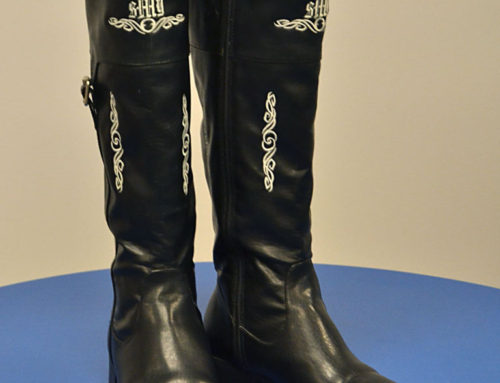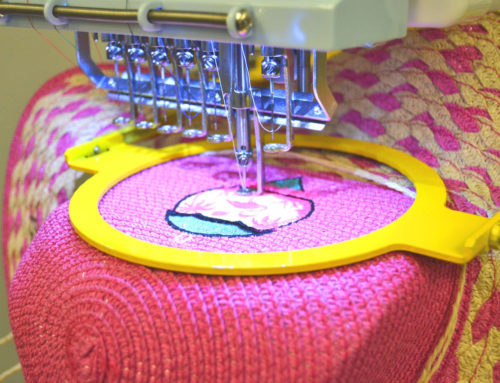We constantly receive questions about embroidery stabilizers, and see many photos of projects that have been ruined just because of wrong stabilizing. So we’ve decided to make a special page about stabilizing.
The rules of stabilizing are simple and logical. Once you understand what every type of stabilizer is supposed to do, see its strong sides and its weak sides, you should be able to match an appropriate embroidery stabilizer for each project easily. Happy reading!
What Is An “Embroidery Stabilizer” and Why Should We Stabilize?
Embroidery stabilizers can be logically divided into two main types: “backings” and “toppings”.
A “backing” is a piece of special material (usually nonwoven) that is placed UNDER the main fabric on which you intend to embroider, to make this fabric more stable. Embroidery backings prevent fabric puckering, fabric stretching and deformation of embroideries after laundry.
“Topping” is placed OVER the fabric on which you want to embroider. Embroidery topping is a special material, designed to stop embroidery stitches from “sinking” into stitches-absorbing types of fabric. For instance, if you embroider on terry cloth, knits, fleece, jersey, velvet, corduroy, artificial fur and so on – embroidery topping is a must. If you forget it, your project will be hopelessly ruined. It’s also nice to use topping even on embroidery-friendly fabric, when you want your design to “stand out” better.
Embroidery toppings often remind nylon film, but usually they aren’t nylon. Most often, embroidery toppings are made out of gelatin-based water soluble substance, and therefore they easily dissolve in warm water once your embroidery is finished. These water-soluble toppings are also called “wash-away”, because they are washed away.
Another type of embroidery topping is heat-away, and they are removed with a hot iron. These ones are tricky. If you get a quality heat-away topping, it will be a blessing. A bad type, however, may leave you VERY angry and disappointed. Why? You’ll discover below, once we explain when it’s best to use each topping type.We constantly receive questions about embroidery stabilizers, and see many photos of projects that have been ruined just because of wrong stabilizing. So we’ve decided to make a special page about stabilizing.
Easy Rules for Stabilizing – When, How, and Why?
1. Stitches-absorbing fabrics:
If you embroider on towels, velvet, fleece or other stitches-absorbing types of fabric, be sure to use topping film, to prevent stitches from sinking into the fabric. This is VERY important – without topping, such projects may be ruined. There are two different types of embroidery toppings available – ones that are washed away with water, and ones that are removed with hot iron.
1.1 Heat-away topping:The beauty of heat-away topping is that you remove it without wetting your project. Naturally, this is the only option when you’re dealing with project that can’t be washed. Using heat-away topping is convenient and fast, so you may prefer to use it whenever your fabric can stand a relatively hot iron.
Heat-away topping tips:
1. If you’re not sure whether your fabric supports iron temperature that is required to remove the topping – take a tiny test-piece of fabric, and try to iron it through a piece of paper.
2. If a low quality heat-away backing is used, it may leave stains and unpleasant smell. So be careful to shop for good stuff.
3. NEVER use steam iron with heat-away topping.
4. It’s often better to put a piece of regular paper over the embroidery, and heat-away the topping through that piece of paper.
1.2 Thin wash-away topping:
Use thin wash-away topping every time that your fabric is not suitable for use with heat-away topping, and wetting your project is possible.
1.3 Thick wash-away topping: Use thick wash-away toping with high-pile fabrics, when you would normally use two layers of thin water-soluble film. If your fabric can support either water soluble of heat away topping – use the type you like more. It may certainly be a matter of personal preference.
2. Heavyweight vs. lightweight fabric: For thick, heavyweight fabrics use thick backings; for thinner, lightweight fabrics, lightweight backing will work better.
3. Dense vs. loose designs: The more dense your embroidery design is, the heavier backing is required; for loose designs, more lightweight backing is better.
4. Stabilizing metallic thread: If you’re using metallic thread, avoid 100% polyester embroidery backing. Try to use embroidery stabilizers with some natural component (cotton or poly-viscose). Natural machine embroidery stabilizers are usually softer, create less friction with embroidery needle and thread, and therefore you embroider with less thread breaks. This is correct for any thread, but is especially noticeable with metallics.
Backing Types & Uses
1. Cutaway Stabilizer: Stretchy and unstable fabrics work best with cut-away stabilizers, because this type of backing can be removed by cutting it away without stretching the embroidered fabric in process. If you embroider on some kind of light-colored, light-weight cloth (like a T-shirt), be sure to use thin, translucent No-Show cutaway backing.
2. Tear-Away Stabilizer: Stable woven fabrics usually work well with tear-away embroidery stabilizer, because when you tear away the excess backing, the fabric that is stable won’t stretch or become deformed. And it is a pleasure to use tear-away embroidery stabilizer when possible, because when it is removed, the back side of the embroidery looks better than after using cutaway (less backing edges can be seen).
3. Water-Soluble Stabilizer: If, for some reason, you need the stabilizer to be removed completely (for example, if you embroider on organza, or create cut-work or stand-alone lace), use strong Water-Soluble stabilizer. Fabric-type water soluble stabilizer is preferable, because it practically doesn’t stretch, “sits” well in hoop, and behaves like regular nonwoven fabric until you wash it away. Fabric type water-soluble backing also doesn’t stiffen (unlike film), and can be stored for many years without losing it’s great qualities.
4. Heat-Away Backing: If one of the following situations apply, use fusible (heat-away) backing, which can be removed from the embroidered item with hot iron:
| 4.1 Your fabric and design need embroidery stabilizer to remain under the stitches, but you can’t use tear-away or cut-away (the design and/or fabric may be too delicate for tear-away and/or too sheer for cut-away). 4.2 Your project is NOT WASHABLE, too delicate for tear-away and/or too sheer for cutaway. 4.3 You’re applying some kind of special technique, like making lace at an edge, and water soluble backing doesn’t provide enough stability. 4.4 You want to create stand-alone embroidery from a design that isn’t digitized as stand-alone (you can just embroider on fusible embroidery stabilizer, cut the excess, then heat away the edges).
Water-soluble embroidery stabilizer is more frequently used for correctly digitized lace designs. The reason is that it’s much easier to remove wash-away backing, than heat-away one. CAUTION: NEVER, NEVER, NEVER use a STEAM iron with fusible stabilizer. The stabilizer will melt and ruin your fabric. |
How To Store Embroidery Stabilizers?
Many machine embroidery stabilizers look alike, and are available in several weights. So it may be a good idea to keep them in the original packaging or in clearly marked nylon bags. Here is a list of identifying info to write on your bags:
1. Name and type of stabilizer
2. Weight of stabilizer
3. How it’s used
4. Brand ( to make sure you re-stock only the good ones )

